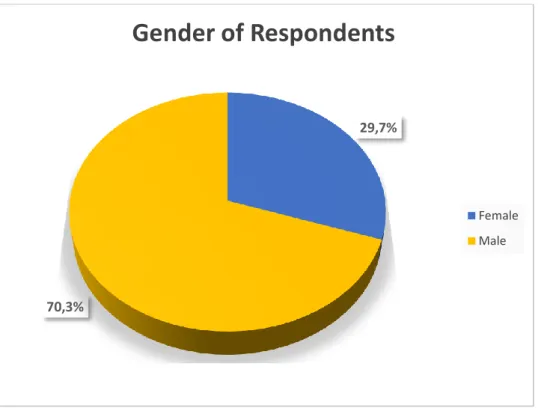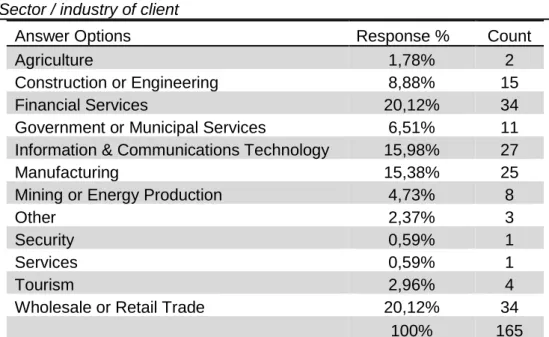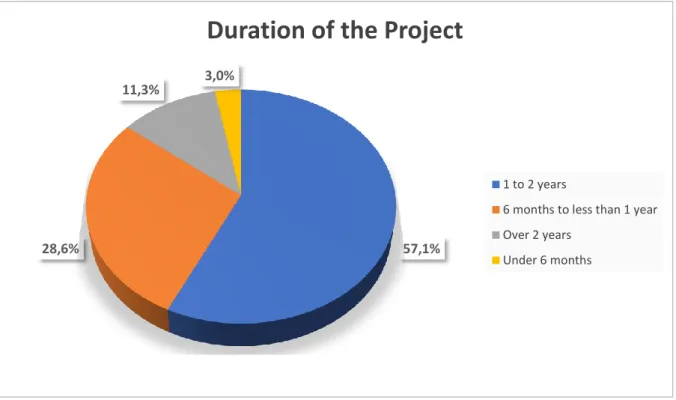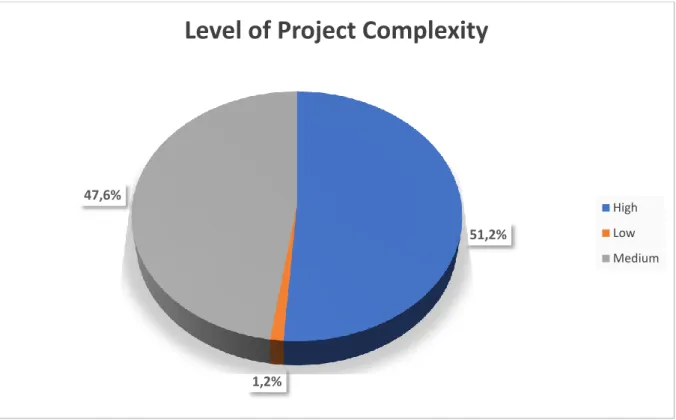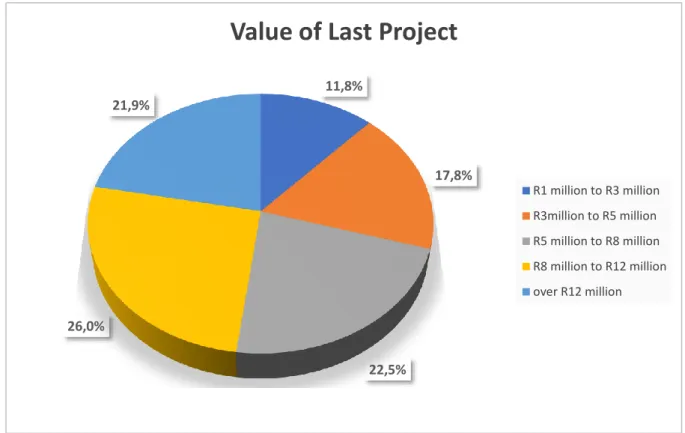This dissertation assesses contrasting approaches to project management and their correlation with ERP project success. Although ERP project success is not correlated with the type of control approach implemented within the project management structures.
Review of the topic
Understanding the title
- Project success definition
- Project governance definition
Governance, but more specifically, corporate governance is a commonly understood concept in academia and business and is well defined by Klakegg, Williams, Magnussen, and Glasspool (2009) as "the use of institutions, authority structures, and even cooperation to allocate resources and coordinate or control activity in society or the economy." Project management is then seen as a mechanism for managing projects that is based on and is an extension of an entity's core management principles, but is specifically applied to individual projects as a management tool that spans the entire project life cycle and dictates a consistent procedure to be followed , enabling the project to be effectively controlled and ensure its successful execution through project practices that are repeatable and have proven fruitful in the past (Joslin & Müller, 2016; Müller & Lecoeuvre, 2014; PMI, 2013 ).
Background to the research topic
The specific success factor explored in this article is that of project governance, and which characteristics of project governance have more impact on achieving project success. Project management principles are applied using the project-relevant set of policies, plans, rules, strategies, responsibilities and procedures to launch, manage and control projects and their outcomes (Pinto, 2014).
Research problem
4 The researcher will attempt to test the implications and strength of the relationship between project management and the positive or negative outcomes of a large-scale ERP project. The use of these two separate paradigms of management enables the researcher to also contrast the different components of the stewardship and agency theories.
Business needs for the study
Theoretical need for the study
6 the team and the organization achieve project success, but there is still a strong debate that concludes that the research that has already been conducted in this area and field has been deficient in terms of what forms of project management lead to the realization of the potential benefits of the project. This research on the use of project management methods to achieve ERP project success will therefore be important to academics as it will help them build on or confirm the relevance of specific theories and contingency theories related to project management, project management and decision making.
Research scope
The motivation for this study is based on the researchers' previous experience with project management and is further inspired by the call for further research as outlined in the study by Joslin and Müller (2016), and will hopefully contribute to the body of knowledge by elucidating the relationship between which project management method, that can be used and whether or not that approach will give an entity a better chance of achieving project success, as well as inspire future researchers to identify alternative methods of project management to determine the most optimal approach that most guarantees project success.
Research purpose
Outline of the research
Introduction
ERP projects
These benefits are realized by the organization, along with the increase in knowledge processing capabilities and the overall success of the company, if the organization is able to effectively utilize the power and capabilities inherent in a sophisticated ERP system (Baykasoğlu & Gölcük, 2017). 11 According to research by Mabert, Soni and Venkataramanan (2001), companies that implement an ERP system that runs over budget and outside the original schedule will assess the implementation as unsuccessful due to not meeting the organization's ambitions, whereas an implementation that is within the pre-approved budget is seen by the business as successful, valuable, and that the ERP system is effective in driving the company's scoped functions.
Project success factors and governance
If the above is true, then this test of linking corporate governance to project governance and their influence on the potential successful outcome of projects fulfills one of the aforementioned criteria of Mills (the philosopher) and the work of Van de Ven (2007) . The other criteria for determining whether there is a causal relationship will be presented in Chapter 6 of this research article, and the possibility of a relationship between the methods of managing projects and the successful outcomes of projects will be explored in the concluding part of the article.
Project success
For this reason, the model of Khan et al. 2013) will be used for this research as it includes the most recent cutting-edge research in the field of project performance. The criteria have been classified to show under which of the five dimensions of project success mentioned above the issues fall.
Project governance
These studies include Wang and Chen's (2006) research on ERP implementations and in particular how the problem of interfirm governance (since a large-scale ERP implementation is generally performed by one to four companies for one specific customer) influences the successful outcomes of the projection. In addition, stakeholder satisfaction in areas outside the United States of America was consistently ranked by project managers as one of the top ten most critical project success factors to consider (Müller & Turner, 2007).
Conceptual framework
Project management can be broken down into its orientation (shareholder versus stakeholder) and its method of control (process & control versus results) (Müller & . Lecoeuvre, 2014). H1 in the conceptual model represents the project management orientation paradigm, where the applied methodology favors shareholder thinking (agency theory) or stakeholder orientation (stewardship theory).
Conclusion
Null hypothesis: H0: There is no statistically significant positive correlation between the stakeholder form of project management and project success. Alternative hypothesis: H1: There is a statistically significant positive correlation between the process/behaviour-controlled form of project management and project success.
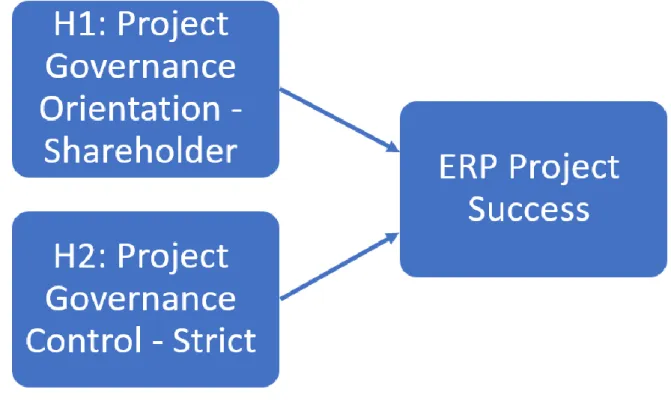
Introduction and research philosophy
Research methodology and design
The time horizon to suit the type of design of this research will be cross-sectional. Due to the limited time period over which the research was conducted, and to be realistic, this research had to be cross-sectional.
Population
Unit of analysis
Sampling method and size
The use of the purposive sampling method helps to uphold the requirement of this research that the respondents are a representation of the target population. Through the purposive non-probability sampling method conducted by the researcher, and among the list of potential respondents created by the account managers and the researcher in their private capacity, a list of approximately 800 potential respondents was created and the surveys were distributed electronically. them.
Measurement instrument
- Project success construct
- Project governance construct
- Questionnaire piloting
Minor changes were made to some of the project success questions to make them specific to ERP projects. Minor changes were made to some of the project management questions to make them specific to ERP projects.
Data gathering process
The purpose of the pilot questionnaire to correct any problems associated with it, correct spelling errors, change the way the questions are asked and to ensure easy usability of the survey. The test subjects for the survey were interviewed in which their individual accounts of their experience of the survey were obtained.
Analysis approach
- Construct validity
- Measuring the reliability of the instrument
- Descriptive statistics
- Analysis of variance across demographics
- Correlation analysis
- Hypotheses testing
The first step in the statistical analysis was to compile a number of different demographics of the respondents. 46 project management constructs due to the scale used to measure respondents' responses.
Research ethics
49 dimension variable will be assigned as the dependent variables, with the method of project management as the independent variable.
Limitations
There is an additional risk that respondents will simply be dishonest or make human errors when answering the survey questions. Unfortunately, even testing the survey may not have been enough to fully mitigate this risk.
Introduction
Survey responses
Respondent demographics
Overall, about 70% (118 people) of the respondents indicated that they had more than 5 years of experience with ERP projects. Over half of the respondents (55%) indicated that the organizational structure adopted was a mixture of a functional organization (a hierarchical organizational structure where people are grouped according to their area of specialization) and a project organization (organizations arrange their activities into programs or portfolios and implement them through projects).
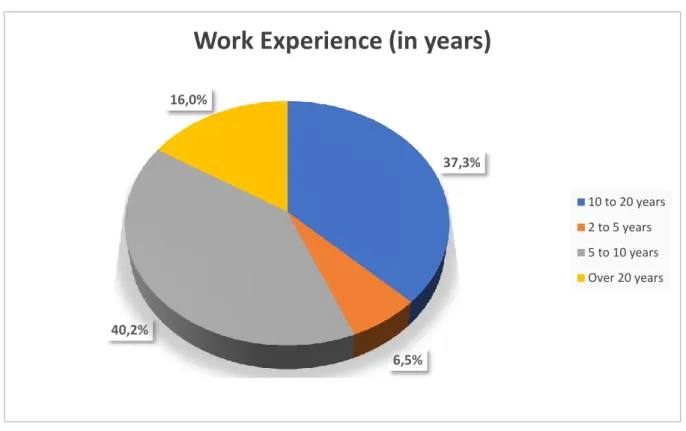
Construct validity
- KMO and Bartlett’s test for sphericity results
- Exploratory factor analysis results
PS_PI_16 The project was perceived as very successful by the customer's competitors and other companies (including other ERP projects and support companies). PS_PE_20 The costs and budget for the project were assessed to have been used effectively.
Project success construct
- Project success – Cronbach alpha results
- Project success – intercorrelations between factors
- Project success – descriptive statistics
- Demographic influence on project success
The reliability for the project reputation dimension of project success was measured as acceptable with a Cronbach's alpha value of 0.814 for the two items. The reliability for the project effectiveness dimension of project success was measured as acceptable with a Cronbach's alpha value of 0.744 for the three items.

Project governance construct
- Project governance orientation construct
- Project governance orientation – descriptive statistics
- Project governance orientation – correlation between items
- Demographic influence on project governance orientation
- Project governance control construct
- Project Governance control – descriptive Statistics
- Project governance control – correlation between items
- Demographic influence on project governance control
Please see Appendix 4 for a detailed list of the questions within the project management orientation construct. Please see Appendix 5 for a detailed list of the questions in the project management control construct.
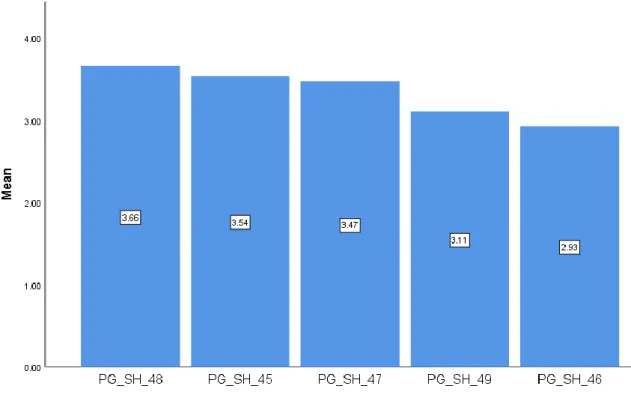
Hypotheses testing
- Hypotheses one – project success & project governance orientation
- Hypotheses two – project success & project governance control
The adjusted R-squared value in the results describes that project management orientation explains 13.8% of the variance in ERP project success (dependent variable. The adjusted R-squared value in the results describes that project management control explains almost no variance in ERP project success ( dependent variable).
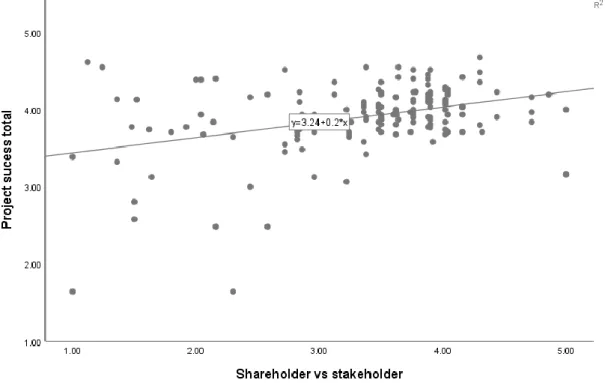
Five dimensions of project success and project governance orientation
The correlation findings show that the project management orientation is mostly positively correlated with the project benefits and stakeholder satisfaction dimension of ERP project success, and least positively correlated with the future potential dimension. These results are also shown graphically in Figure 18 below and are discussed in detail in the next chapter.
Conclusion
Introduction
Sample demographics
The four that account for most of the industries selected are financial services (20%), wholesale or retail trade (20%), ICT (16%) and manufacturing (15%). Respondents indicated that 72% of the relevant ERP projects were carried out in the City of Johannesburg.
Project success construct
However, all project success dimensions were significantly correlated with the project success construct as a whole, lending additional credibility to the questions that make up the construct (Serrador & Turner, 2015). Complementing this, the project duration demographic had the largest and most significant effect on the project costs, deadlines, and scope dimension of ERP project success.
Project governance construct
- Governance orientation – shareholder versus stakeholder
- Governance control – behaviour versus outcome
A Pearson correlation coefficient test on the construct revealed that the correlations between each of the project governance orientation questions (appendix 4) can be considered strong and significant, giving credibility to the importance of the questions and the construct as a whole (Wegner, 2016 ). The effect of project duration on respondents' mean responses to the project governance orientation construct was then found not to be significant through post hoc ANOVA analysis.
Research hypotheses
- Hypothesis one - governance orientation and project success
- Hypothesis two - governance control and project success
Alternative hypothesis: H1: There is a statistically significant positive relationship between the form of project management by stakeholders and project success. Linear regression modeling revealed that project management control was not significantly related to ERP project success.
Project governance and the project success dimensions
Discussion summary
Introduction
Recap of the research objectives
Summary of the research findings
The results of the first hypothesis test revealed that there is a statistically significant positive correlation between the stakeholder form of project governance and project success, and that 13.8% of the variance in ERP project success can be described by the location of governance orientation along the shareholder versus stakeholder scale. The results of the second test indicate that the hypothesis that here there is a statistically significant positive correlation between the process/behaviour-driven form of project governance and project success cannot be proven with the collected research data, as the project governance control method does not. have a significant relationship to the success of ERP projects.
Recommendations and implications
- Practical implications for business and management
- Theoretical implications
- Suggestions for future Research
At the same time, there are aspects of this study that show some of the limitations of agency theory methods of project governance. In addition to any suggestions made in section 7.4.2 above, further research should be done around the topic of project management and ERP project success that focuses on the specific content of the relationship between the various sub-dimensions of project success and ERP project success.
Limitation of the study
Covariance was shown in construct testing through regression modeling that project governance orientation is significantly related to project success. However, causality between organizational governance and project success cannot be claimed in its entirety in this research as cross-sectional limitations and the specific focus of the research did not allow time sequence and non-spurious association conditions to be adequately tested.
Conclusion
The impact of project management (PM) and benefits management (BM) practices on project success: Toward development of a project benefits management framework. The impact of relational norms on information technology project success and its moderation through project management.
Appendix 1 - Online survey
The company that offers ERP services (the company that concluded the contract for the implementation of the project in conjunction with the client) was satisfied with the results of the project. Competitors and other companies (including other ERP project companies and support companies) rated the project as highly successful.
Appendix 2 – Project success factors
Appendix 3 - Project success questions
Appendix 4 - Governance questions: shareholder vs stakeholder
Appendix 5 - Governance questions: behaviour vs outcome control
Appendix 6 – Post hoc ANOVA results for project success
Appendix 7 – Consistency matrix
Appendix 8 – Ethical clearance

